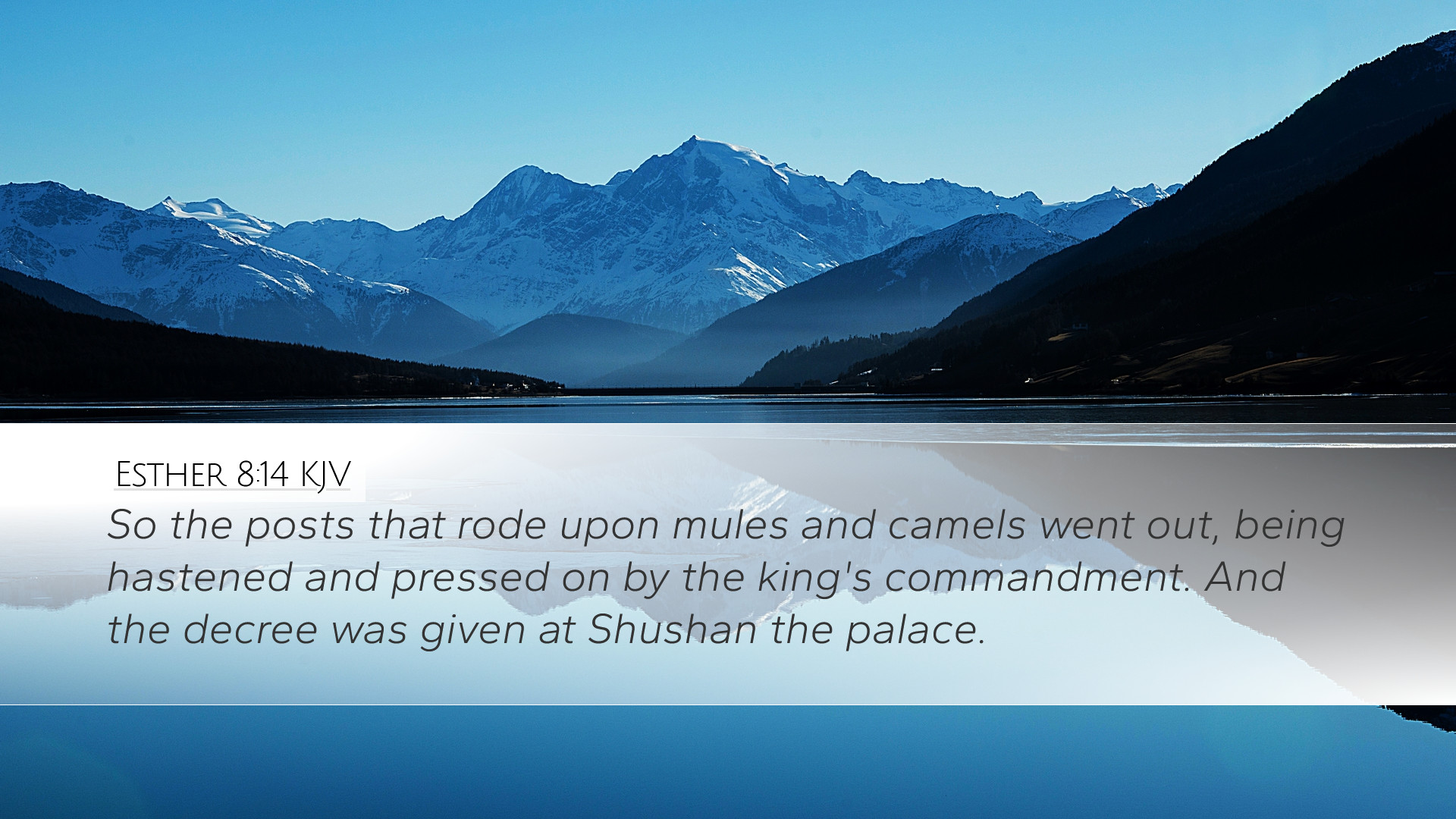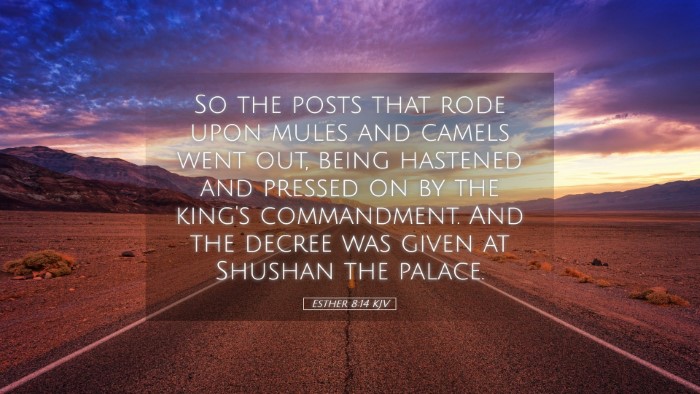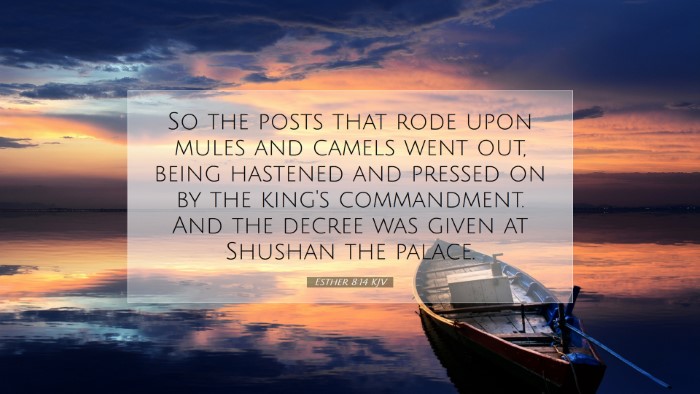Old Testament
Genesis Exodus Leviticus Numbers Deuteronomy Joshua Judges Ruth 1 Samuel 2 Samuel 1 Kings 2 Kings 1 Chronicles 2 Chronicles Ezra Nehemiah Esther Job Psalms Proverbs Ecclesiastes Song of Solomon Isaiah Jeremiah Lamentations Ezekiel Daniel Hosea Joel Amos Obadiah Jonah Micah Nahum Habakkuk Zephaniah Haggai Zechariah MalachiEsther 8:14
Esther 8:14 KJV
So the posts that rode upon mules and camels went out, being hastened and pressed on by the king's commandment. And the decree was given at Shushan the palace.
Esther 8:14 Bible Commentary
Commentary on Esther 8:14
Esther 8:14: "So the post that rode upon mules and camels went out, being hastened and pressed on by the king's commandment. And the decree was given at Shushan the palace."
Introduction
The Book of Esther is a tale of providence, bravery, and the survival of the Jewish people. It showcases the extraordinary circumstances that lead to deliverance from impending doom. Esther 8:14 highlights the immediacy with which the decree to save the Jews was sent out, illustrating the urgency of God's providence and the role of Esther and Mordecai in promoting justice.
Public Domain Commentary Insights
Matthew Henry's Commentary
Matthew Henry emphasizes the importance of timely action in matters of justice. He observes that the king's command to hasten the delivery of the message indicates the seriousness of the decree's significance. This command not only shows the urgency but also the necessity of establishing a response to Haman's earlier edict. The king, recognizing the potential devastation facing the Jewish people, quickly moves to counteract this peril.
Henry further reflects on the symbolism of the "mules and camels," which represent strength and speed. They are animals fit for royal transportation and signify that the message of hope and salvation should reach all corners of the kingdom without delay. The fact that the decree was sent from “Shushan the palace” also points to authority and a firm backing from the king, ensuring that the message not only had power but also the potential to change the fate of an entire people.
Albert Barnes' Commentary
Albert Barnes focuses on the operational aspects of the decree, noting the mode of communication employed by the king. According to Barnes, the use of post-riders - especially noteworthy animals like mules and camels - represents a well-coordinated military and logistical effort encompassing the entire Persian Empire. He illustrates how this logistics system signifies the importance of the decree against the backdrop of the previous threat against the Jews.
Barnes highlights the contrasts in the narrative: where despair once loomed from Haman's decree, now there is a proactive and immediate response to ensure the safety of the Jews. This transition from peril to protection signifies a turning point not only for the Jewish people but also for the governance of the empire, showcasing the pivotal role of leadership in effecting social change.
Adam Clarke's Commentary
Adam Clarke elaborates on the implications of the decree itself and the urgency with which it was executed. He discusses the broader themes of justice and divine providence inherent in the text. Clarke draws attention to the way God orchestrates events even through human agencies—the post-riders being a means through which the message of deliverance is spread. He underlines the importance of this divine orchestration in moments of crisis, reminding the reader of God's sovereignty over earthly affairs.
Clarke also notes that the use of camel-mounted riders alludes to the far-reaching implications of the decree. The decree was not merely a local event; it was to be disseminated across vast regions of the empire, indicating that the Jews' deliverance was to be a public and celebrated event. This public acknowledgment of their right to defend themselves transforms the narrative from one of impending doom to one of triumph and celebration.
Theological Reflections
Esther 8:14 stands as a powerful reminder of the ways in which God provides for His people in times of distress. Each of the commentators draws attention to the immediate execution of the command as a divine response to human injustice. The urgency with which the message is sent reinforces the notion that God is aware of the struggles of His people and actively orchestrating their deliverance.
- The Role of Divine Providence: The rapid delivery of the decree demonstrates God’s providential care and the belief that He is always at work behind the scenes, turning situations for good.
- Leadership and Responsibility: The roles of Esther and Mordecai highlight how God uses willing hearts and courageous leaders to fulfill His promises. It showcases the call for believers to rise to positions where they can influence for good.
- The Importance of Justice: The swift action taken by the king underscores the necessity of justice in governance. This call for justice remains relevant today as leaders are challenged to act righteously in the face of oppression.
Application for Today
The themes illuminated in Esther 8:14 reach far beyond the historical context of the Persian Empire. For today’s pastors, theologians, and students of the Word, this verse emphasizes the importance of timely intervention and the necessity of standing up against injustice. It serves as a call to be vigilant custodians of justice in our communities.
As modern believers explore their roles in the face of societal challenges, the account of Esther equips them with the understanding that their actions can pave the way for hope and deliverance. Just as Esther and Mordecai acted for the wellbeing of their people, today’s leaders are called to navigate their contexts with wisdom, decisiveness, and a commitment to God’s justice.
Conclusion
Esther 8:14 is a profound reminder of God's sovereignty and the role of faithful leaders in promoting justice and redemption. Through the insights of Matthew Henry, Albert Barnes, and Adam Clarke, this verse comes alive with meaning and relevance, inspiring reflection and action among believers.


